Introduction
Imagine navigating the winding waters of the Amazon River, where some of the world’s most fascinating and dangerous snakes lie beneath the surface.
The snakes in the Amazon River represent a diverse and captivating array of species; each adapted to thrive in one of the planet’s most complex ecosystems. From the massive anacondas to the elusive water snakes, these creatures play a vital role in the river’s biodiversity. This article delves into the lives of these remarkable reptiles, exploring their habits, habitats, and the unique adaptations that allow them to flourish in the Amazon’s dynamic environment.
Understanding the snakes in the Amazon River highlights their importance within the ecosystem and sheds light on the intricate balance of life in this incredible region. Join us as we uncover the secrets of the snakes in the Amazon River and their crucial role in maintaining the ecological harmony of the Amazon.
Read also: Ecosystem | Definition, Components, and 5 Important Types of Ecosystem
Read also: Facts about the Amazon Rainforest: Uncover the Disturbing Secrets it Holds
Diversity of the Snake species found in the Amazon
Although some reptile groups are diverse, others can be found in lesser numbers than in the same areas in the Asian tropics. For instance, turtles, tortoises, and venomous snakes are less common than other humid tropical areas worldwide. Amazonian reptiles inhabit various environments, including creeks, oxbows, and the rainforest canopy, and exhibit diverse feeding habits. Most reptiles, such as the boa, are carnivorous, feeding exclusively on other animals, while others, like the green iguana, are primarily herbivorous, mainly consuming plant matter.
Unique and Notable Species of Snakes in the Amazon
The two main types of snakes in the Amazon River basin are the Anaconda and the Boa. Different varieties of these two species slither in dense evergreen jungles. Other species found may be the Mussurana, Pit Viper, Eyelash Viper, etc.
Anaconda:
Anacondas are giant snakes located in the Amazon rainforest. They can develop to 30 feet in length and weigh up to 250 kilograms. It is considered that the Green Anaconda, which is the most extensive variety of snakes in the Amazon River, can be divided into two particular species. Green anacondas are renowned as the most significant type of giant snake. These formidable creatures inhabit the Amazon Rainforest, often slinking through marshes and rivers. It is usually seen that the inhabitants of Waorani in the Ecuadorian Amazon have witnessed anacondas of up to 500kg.
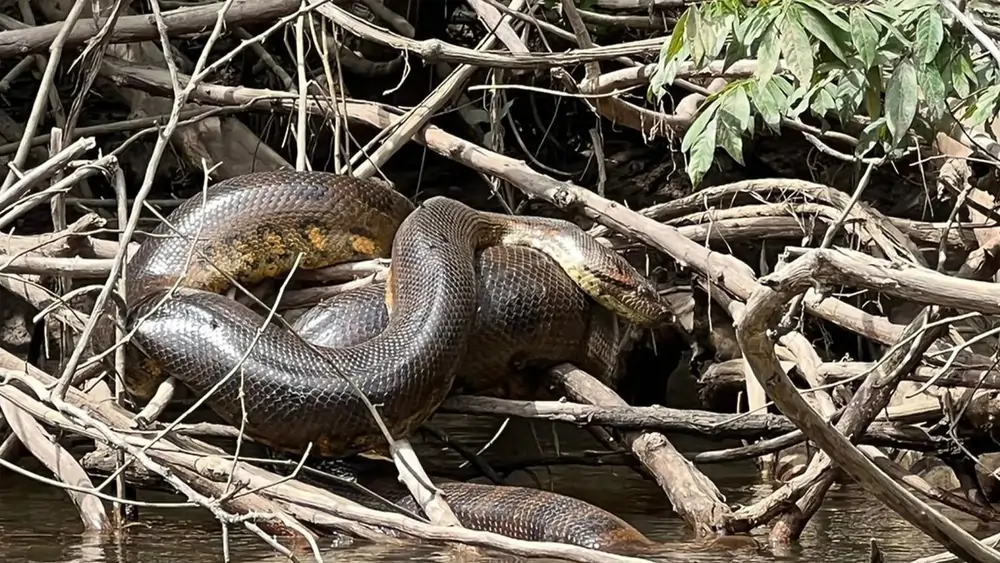
The yellow anaconda is a species of boa native to southern South America and a common variety of snakes in the Amazon. It is one of the largest snakes in the world but smaller than its sister species, the green anaconda. Like all boas and pythons, it is nonvenomous but hunts its prey by constriction. Adults grow to a total length of 3.7m, but females are mainly larger than males and up to about 4.6 m in length. The color pattern consists of a yellow, golden tan, or greenish-yellow ground color with spots, streaks, and blotches.
Read also: Top 12 World’s Most Venomous Snakes: A Deadly Dozen
Coral Snakes:
The coral snake is a term for over 100 species of small, secretive, and vividly patterned poisonous snakes belonging to the cobra family (Elapidae). In the New World, coral snakes vary from 40 to 160 cm. Micrurus, the genus with the most New World coral snakes, comprises around 80 species. These snakes are found in the southern United States and Argentina. Amazon Coral Snakes and Aquatic Coral Snakes are Aquatic Coral Snake are common variety of snakes in the Amazon.
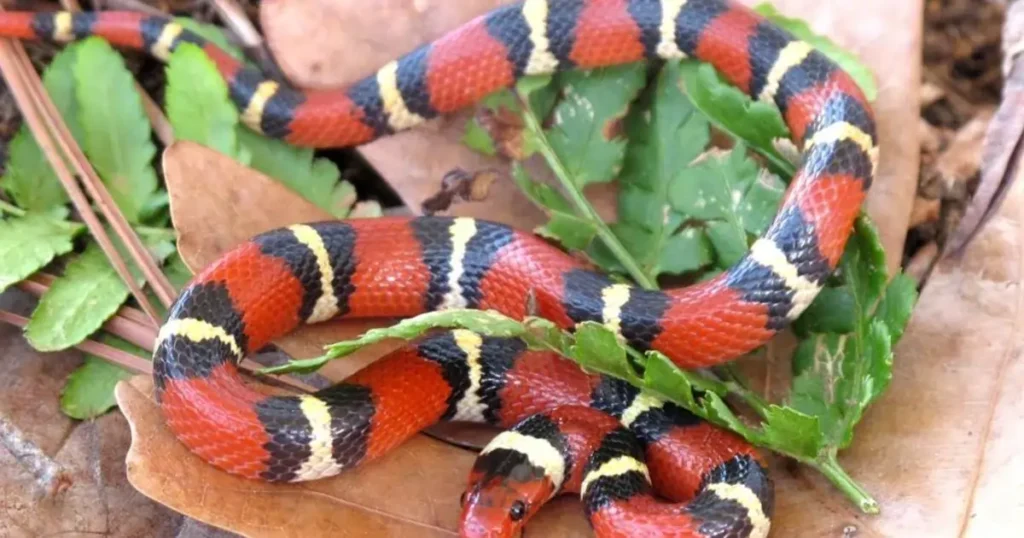
Coral snakes are highly venomous, among the strongest of any snake on Earth, and can be easily seen by their red, black, and yellow patterned bodies. Unlike other venomous snakes, coral snakes have weak fangs that are always visible as they cannot retract them. Surprisingly, coral snake bites cause minimal initial pain and no swelling in humans, with symptoms often taking hours to appear.
Read also: Animals of North America: 20 Astonishing Creatures You Must Discover
Boas:
In South America, boas are commonly referred to as boines and are undoubtedly some of the most famous snakes in the world. The diverse boine fauna of the Amazon River Basin and the Guianas includes five species: the boa constrictor (Boa constrictor), the emerald tree boa (Corallus caninus), the typical tree boa (Corallus enydris), the rainbow boa (Epicrates cenchria), and the green anaconda (Eunectes murinus). These species are distributed on the mainland of South America.

Bushmasters:
The two main variants of bushmaster snakes in the Amazon are Bushmaster L. Muta and Bushmaster L. Stenophrys. Bushmaster L. Muta is the longest poisonous snake in the Americas.
These are mainly 2 to 3cm, but some may grow to a certain length of 4m, which makes them one of the most poisonous snakes in the Western Hemisphere and one of the longest vipers in the viper family. They lay eggs in a mean clutch of a dozen. Bushmasters can have multiple bite strikes and use a lot of venom. The average hatchlings are 30 cm in length.
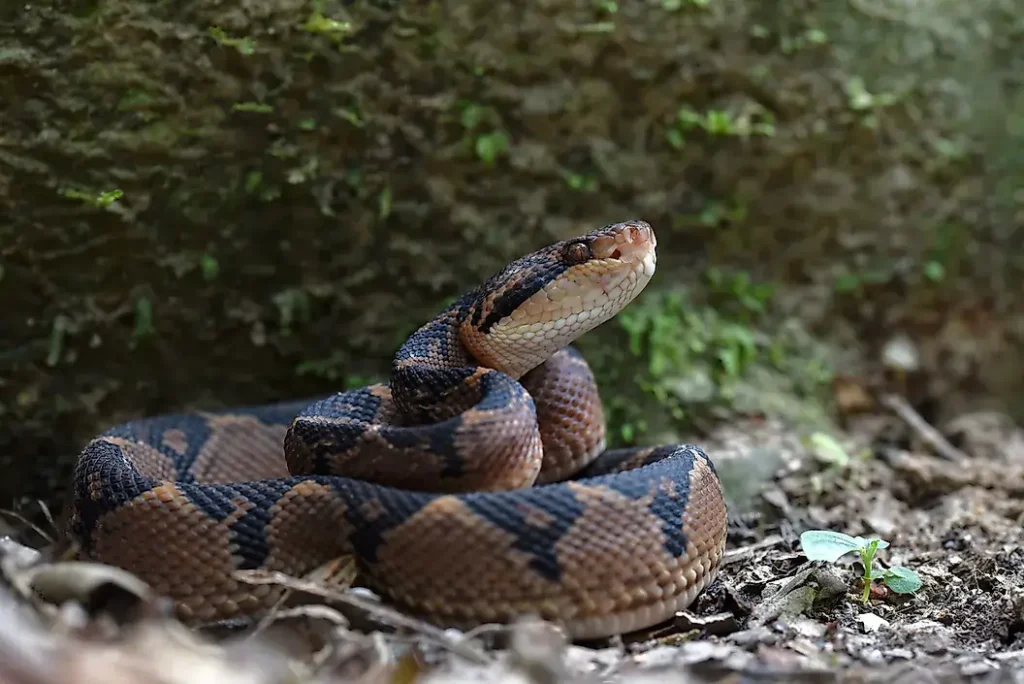
Fer-de-lance:
They belong to the viper family and are poisonous because they are found in diverse habitats, from cultivated lands to forests, throughout tropical America and Tropical Asia. The jumping viper has a huge triangular head, usually about 1.2 to 2 meters. It is grey in color, marked by a series of black-edged diamonds, but it is often seen in a lighter color. The jumping viper is an aggressive brown or gray Central American snake with diamond-shaped crosswise markings on its back. The availability of this species has enriched the diversity of snakes in the Amazon.
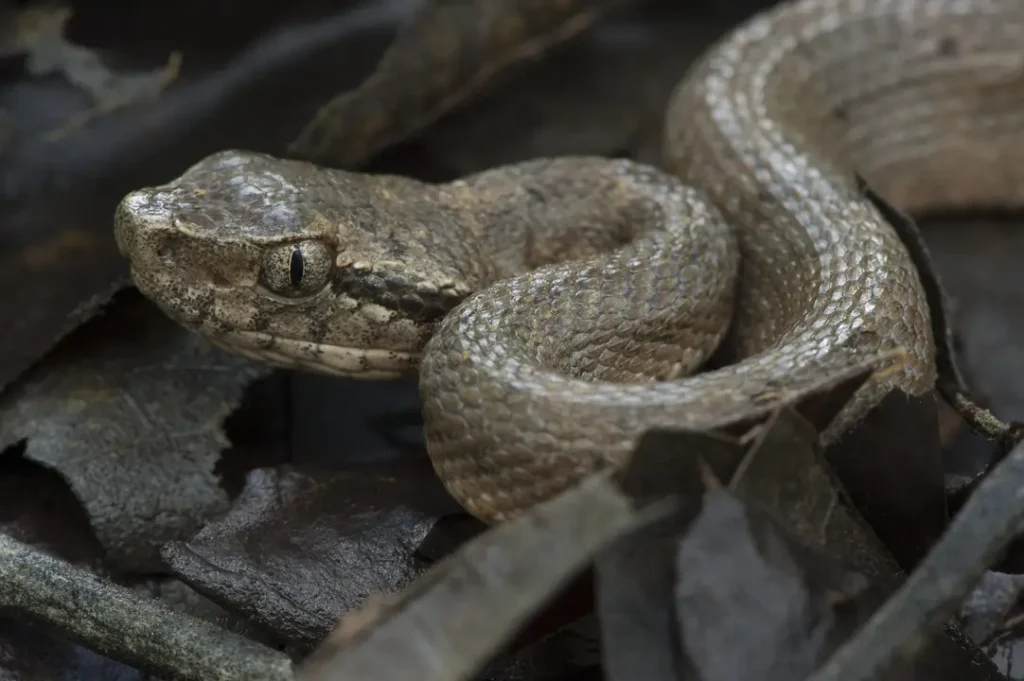
Adaptations of these snakes to the ambiance of the Amazon
Snakes in the Amazon forests are well-adapted to an arboreal or tree-dwelling lifestyle. Many have long, slender bodies with angled scales on their bellies, which aid in gripping branches. Some species have even developed ‘wings’ that allow them to glide to another tree or the ground to escape predators.
While ground-dwelling snakes track their prey by scent, arboreal snakes rely on sight, as scent trails are frequently broken when prey moves between branches. Some tree-dwelling snakes have prehensile tails that can firmly grip branches, providing stability as the rest of their body moves. These snakes are also well-camouflaged, typically displaying green or brown colors with patterns resembling twigs or leaves to blend in with their surroundings.
Habitats and Behaviors of Amazonian Snakes
Habitats
The Amazon rainforest offers various habitats, ranging from rainforest canopy to Savannas, where various snakes thrive. Interpreting these habitats helps to praise the ecosystem adaptations of the snakes in the Amazon.
Rainforest Canopy:
The upper part of the forest, called the canopy, is home to many arboreal snakes. These snakes got used to the ambiance of tree life while utilizing their long, slender bodies and specialized scales for gripping branches. The canopy provides ample hunting opportunities, as these snakes prey on birds, small mammals, and tree-dwelling amphibians.
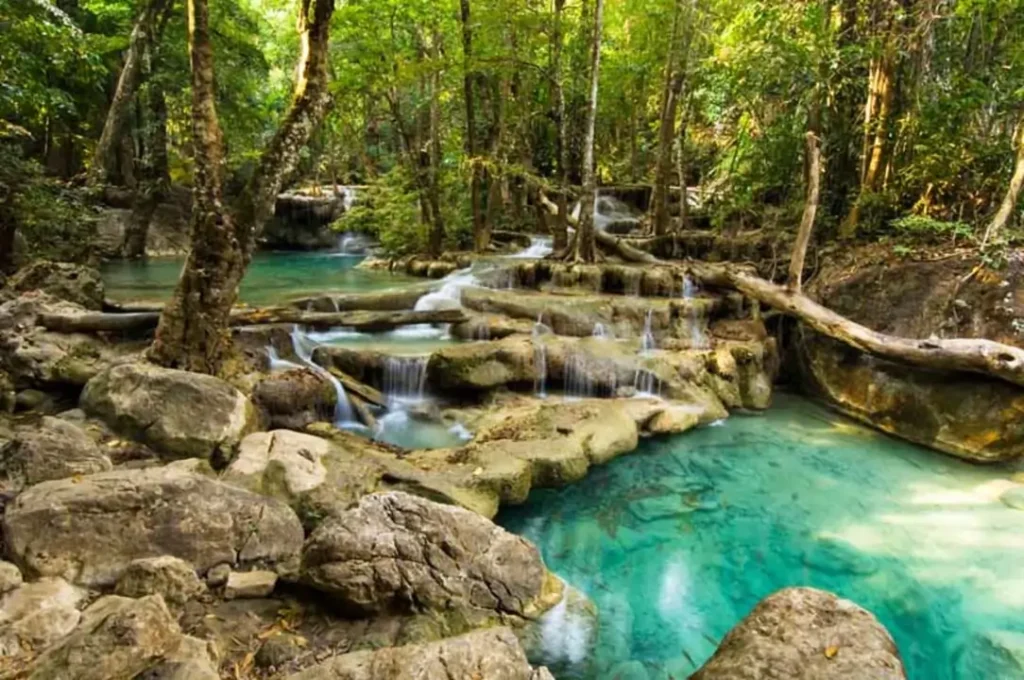
Read also: Rainforest Food Web: Brutal or Beautiful? Explore the Jungle’s Hunger Games
Forest Floor:
The forest floor is a rich habitat teeming with life and decay. Ground-dwelling snakes, such as the boa constrictor and the fer-de-lance, are well-suited to this environment. The forest floor’s thick vegetation and fallen logs offer hunting grounds and protection from predators.
Wetlands and Marshes:
Wetlands and marshy areas within the Amazon, including swamps and flooded forests, are ideal habitats for semi-aquatic snakes. The anaconda, one of the most giant snakes in the world, is frequently found in these environments. The abundance of water and dense vegetation provide food and cover to these snakes in the Amazon.
Read also: Are Mangrove Snakes Dangerous? 5 Rare Facts
Riverbanks and Oxbows:
Riverbanks and oxbows, U-shaped bends in rivers, are also significant habitats for Amazonian snakes. The constant water flow and varying depths offer diverse ecological niches for different snake species. The existence of water draws in several snakes, making it the primary place for capturing its prey.
Savannas and Open Areas:
While primarily known for its dense forests, the Amazon Rainforest also contains savannas and open areas where snakes like the bushmaster can be found. These areas are characterized by sparse tree cover and grassy expanses, and snakes often prey on small mammals and birds.
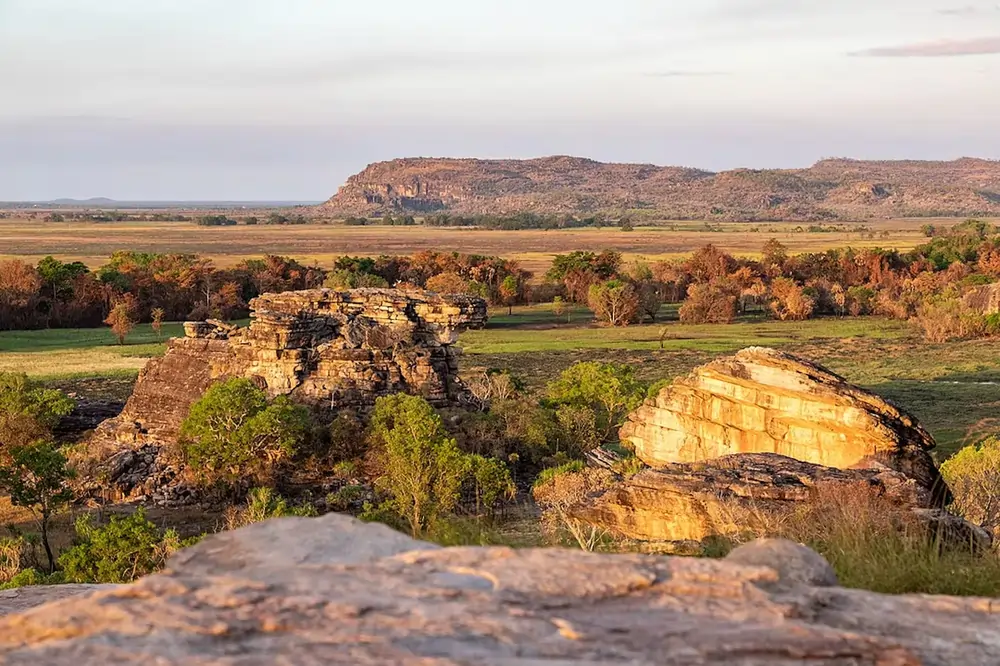
Read also: Savanna Food Web: 3 Astonishing Predator-Prey Relationships of This Complex Ecosystem
Behavioral Patterns
Amazon rainforest snakes have various hunting and eating strategies, reflecting their ability to adapt to different habitats. Many Amazon snakes, such as boa constrictors, are ambush predators; they stay camouflaged in their environment, but once they catch their prey, they hunt, making them effective hunters. For instance, green anacondas hunt for their prey and are mighty swimmers who often find their prey in waterbodies. Some have specified diets. For example, the oa mainly feeds on birds and other arboreal mammals, while the green iguana describes the herbivorous characteristics of some reptiles.
Ecological Roles & Importance of Snakes in Amazon River
The Amazon River snakes play a crucial role as the food chain’s users and prey. Their existence helps maintain the populations of other animals, ensuring the well-being and stability of the ecological environment are well maintained. The heavy and dense rainforest, with a complex network of trees, vines, and waterways, provides a proper habitat for these vipers, giving them ample opportunities for chasing and protection.
Symbiotic relationships with other species: Both benefit from the relationship between Anaconda and cleaner fish. For instance, cleaner fish assist in eliminating dead skin and parasites from Anaconds’ bodies. In response, cleaner fish help get a reliable food source and shelter from larger predators.
Read also: Importance of Food Chains In The Energy Flow In The Ecosystem
Read also: Why is Food Web Important? Types of Food web
Major Threats & Conservation of Amazonian Snakes
Major threats
The major threats that the snakes in the Amazon rivers face include deforestation and urbanization, where the growth of urban areas depletes the snakes’ natural habitats and shelter. In addition, climatic changes and fluctuations in weather, which increase the frequency of storms and droughts, harm the snakes’ breeding cycle. Along with this is hunting and poaching, where the snakes are often hunted for their skin and used to manufacture traditional medicine.
Current Conservation Status
The ‘Save The Snakes Ecuador Ecotour’ (November 11-21, 2023) explored the Amazon rainforest, the cloud forest of the Mindo Valley, and the Páramo of the Andes. This tour offers abundant opportunities to find and photograph snakes and other wildlife in their natural habitats. This ecotour combines sustainability with personal comfort, as participants stayed in first-class ecolodges that prioritized environmental protection while providing an unforgettable guest experience.
Developed by Save The Snakes Founder and Executive Director Michael Starkey, who has over ten years of experience organizing eco-tours in Belize, Costa Rica, and Ecuador, this trip highlighted Ecuador’s incredible biodiversity, landscapes, and ecosystems. With its many snakes, Ecuador is an ideal Save The Snakes Ecotour destination. Additionally, you will learn how this ecotour supports local communities, preserves habitats, and protects wildlife populations.
Establish national parks and reserves to safeguard species and animals from deforestation and human activities. Proper education and raising awareness are needed to educate the local inhabitants to protect trees from deforestation. Conduct scientific research to properly interpret snakes’ populations, behaviors, and ecological roles.
Read also: Biodiversity Crisis: 5 Shocking Ways We’re Losing Nature’s Riches
Read also: Climate Change Affects the Fate of the Amazon Forests: 3 Alarming Tipping Points You Need
Conclusion
In conclusion, the snakes in the Amazon River are a testament to this extraordinary region’s rich biodiversity and intricate ecosystem. These snakes, from the formidable anaconda to the agile water snakes, demonstrate remarkable adaptations that enable them to thrive in such a dynamic environment. Understanding the snakes in the Amazon River provides valuable insights into their roles as both predators and prey, maintaining the delicate balance of the Amazon’s food web.
Their presence underscores the importance of preserving this unique habitat, as each species contributes to the ecosystem’s overall health. As we continue to explore and learn about the snakes in the Amazon River, we gain a deeper appreciation for the complex interdependencies that sustain life in one of the world’s most fascinating natural wonders. Protecting these incredible reptiles and their environment is crucial for maintaining the biodiversity and ecological integrity of the Amazon.
FAQs
1. What is the biggest snake in the Amazon River?
The biggest snake found in the Amazon River is the green anaconda (Eunectes murinus). These massive constrictors can grow up to 30 feet (9 meters) long and weigh over 550 pounds (250 kilograms). They are non-venomous but powerful predators, capable of ambushing and squeezing large prey like caimans, capybaras, and even jaguars.
2. Are there venomous snakes in the Amazon River?
Yes, several venomous snakes are found in and around the Amazon River. Some of the most notable include:
Bushmaster: The largest venomous snake in the Americas, known for its potent venom and large fangs.
Fer-de-lance: A highly venomous pit viper with a wide distribution throughout South America.
Coral snakes: Small, brightly colored snakes with neurotoxic venom.
Amazonian rattlesnake: A venomous pit viper found in the rainforests of the Amazon basin.
3. How many species of snakes are found in the Amazon River?
The Amazon rainforest is home to an incredible diversity of snakes, with over 300 species estimated to live in the region. Many of these snakes inhabit the river or the surrounding wetlands and forests.
4. What do snakes in the Amazon River eat?
The diet of Amazon River snakes varies depending on the species and size. Smaller snakes typically feed on fish, amphibians, and small rodents, while larger snakes like the anaconda can consume larger prey like caimans, capybaras, and even deer. Some snakes, like the coral snake, feed on other snakes.
5. How many different species of snakes live in the Amazon River?
The Amazon River basin is one of the most biodiverse regions on Earth, and it’s home to an estimated 150 species of snakes, including various venomous and non-venomous species, from small, colorful tree snakes to massive constrictors like the anaconda.
6. What role do snakes play in the Amazon River ecosystem?
Snakes are crucial in the Amazon ecosystem as predators and prey. They help control populations of rodents, fish, and other small animals while also serving as a food source for larger predators like caimans and birds of prey. Their presence contributes to the balance of the complex food web in the Amazon rainforest.
References:
- Amazon reptiles. (n.d.). Panda.org. Retrieved May 21, 2024, from https://wwf.panda.org/discover/knowledge_hub/where_we_work/amazon/about_the_amazon/wildlife_amazon/reptiles/
- The new anaconda in the Amazon Jungle could be the “biggest” snake species alive. (n.d.). BBC. Retrieved May 21, 2024, from https://www.bbc.com/newsround/68371446
- The Editors of Encyclopedia Britannica. (2024). coral snake. In Encyclopedia Britannica.
- Amazon reptiles. (n.d.). Panda.org. Retrieved May 21, 2024, from https://wwf.panda.org/discover/knowledge_hub/where_we_work/amazon/about_the_amazon/wildlife_amazon/reptiles/
- Rainforest Animals. (n.d.). Young People’s Trust For the Environment. Retrieved May 21, 2024, from https://ypte.org.uk/factsheets/rainforest-animals/snakes
- Andes to the Amazon: The Save The Snakes Ecuador Ecotour. (2022, December 19). Save The Snakes. https://savethesnakes.org/ecuador2023/

